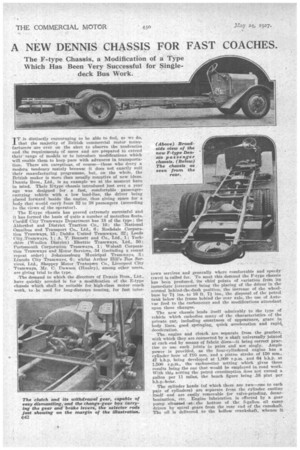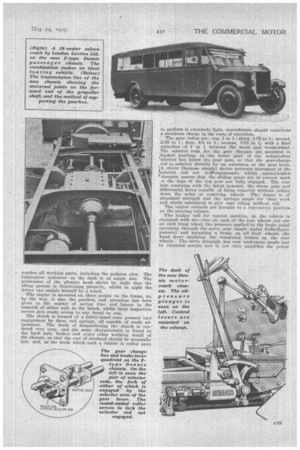A NEW DENNIS CHASSIS FOR FAST COACHES.
Page 100

Page 101

Page 102

If you've noticed an error in this article please click here to report it so we can fix it.
The F-type Chassis, a Modification of a Type Which Has Been Very Successful for Singledeck Bus Work.
IT is distinctly encouraging to be able to feel, as we do, that the majority a British commercial motor manufacturers are ever on the alert to observe the tendencies and the requirements of users and are prepared to extend their-range of models or to introduce modifications which will enable them to keep pace with advances in transportation. There are exceptions, of course—those who decry a modern tendency mainly because it does not exactly suit their manufacturing programme, but, on the whole, the British maker is more than usually receptive of new ideas. Dennis Bros., Ltd., is an example we at the moment have in mind. Their Eltype chassis introduced just over a year ago was designed for a fast, comfortable passengercarrying vehicle with a law load-line, the driver being placed forward beside the engine, thus giving space for a body that would curry from 32 to 38 passengers (according to the views of the operator).
The E-type chassis has proved extremely successful and it has formed the basis of quite a number of motorbus fleets. Cardiff City Tramways Department has 18 of the type ; the Aldershot and District Traction Co., 10; the National Omnibus and Transport Co.. Ltd., 6; Rochdale Corporation Tramways, 15; Dublin United Tramways, 32; Leeds City.Tramways, 1; A. 7. Bennett and 0o., Ltd., 1 ; Yorkshire (Woollen District) Electric Tramways, Ltd., 50; Portsmouth Corporation Tramways, 1; Walsall Corporation Tramways and Motor Services, .34 (including a recent repeat order) ; Johannesburg Municipal Tramways, 5; Lincoln City Tramways, 6; whilst Arthur Hill's Bus Servicei, Ltd., Sheppey Motor Transport Co., Liverpool City Tramways, Mr. C. Dawson (Hanley), among other users, are giving trial to the type.
The demand to which the directors of Dennis Bros., Ltd., have quickly acceded is for a modification of the E-type chassis which shall be suitable for high-class motor coach 'work, to be used for long-distance touring, for fast inter town serviees and generally whore comfortable and speedy travel is called for. To meet this demand the E-type chassis has been produced, its chief points of variation from its immediate forerunner being the placing of the driver in the normal behind-the-dash position, the increase of the wheelbase by 7i ins. to 16 ft. 7i ins., the disposal of the petrol tank below the frame behind the rear axle, the use of Autovac feed to the carburetter and the modifications attendant upon these changes.
The new chassis lends itself admirably to the type of vehicle which embodies many of the characteristics of the private car, including smartness of appearance, grace in body lines, good springing, quick acceleration and rapid., deceleration.
Theengine and clutch are separate from the gearbox, with which they are connected by a shaft universally jointed at each end by means of fabric discs—it being correct practice to use such joints in pairs and not singly. Ample power is provided, as the four-cylindered engine has a cylinder bore of 110 11111111. and a piston stroke of 150 mm., 47 b.h.p. being developed at 1,000 r.p.m. and 64 b.h.b. at 1,500 r.p.m., the carburetter setting which gives these results being the one that would be employed in road work. With this setting the petrol consumption does not exceed a gallon per 11 miles, the bench figure being .58 pint per b.h.p.-hour.
The cylinder heads (of which there are two—one to each pair of cylinders) are separate from the cylinder, casting itself and are easily removable for valve-grinding, decarbonisation, etc. Engine • lubrication is effected by a gear pump situated ,at• the bottom of the 3-gallon oil sump driven by spiral gears from the rear end of the camshaft. The oil is delivered to the hollow crankshaft, whence it
reaches all working parts; including the gudgeon pins. The lubrication indientor on the dash is of ample size. The protrusion of the plunger head shows by sight that the oiling system is functioning properly, whilst at night the driver :an satisfy himself by a touch.
The engine is mounted on three points on the frame, as, by the way, is also the gearbox, and attention has been given to the matter of saving time and labour in the removal of either unit to the bench, whilst large inspection covers give ready access to any detail in situ.
The clutch is formed of a fabric-faced cone pressed into engagement by three coil springs, all capable of ready adjustment. The work of dismembering the clutch is rendered very easy, and the same characteristic is found in the back axle, brakes and every other working detail of the chassis, so that the cost of overhaul should be unusually low, and, as the work which such a vehicle is called upon
to perform is extremely light, maiiittn-ance should constitute a minimum charge in the'costs of operation.
The gear ratios are : top, 1 to 1; third, 1.75 to 1; second, 2.76 to 1; first, 4.5 to 1; reverse, 3,73 to 1, with a final .reduction of 7 to 1 between the worm and worm-wheel. The selector rods for the gear changes are mounted in ;bushed bearings iu \the lower part of the independent selector box below the gear gate, so that the gear-change rod is selected directly by. an extension on the gear lever. jA, clever (because simple) device prevents movement of the r3elector rod not in eengagement, whilst spring-loaded r3lurigers ensure that the sliding gears are in correct mesh
tbe dogs of the top gear are fully engaged. The rear axle conforms with the latest practice, the worm gear and differential being capable of being removed without taking down the axles or removing wheels. The frame is of abundant strength and the springs ample for their work and nicely calculated to give easy riding without Fell.'
The engine controls are brought to a convenient position on the steering column.
The brakes call for special mention, as the vehicle is equipped with six—two 011 each of the rear wheels and one on each front wheel, the pressure applied to the brake pedal operating through the servo gear (made under Rolls-Royec patents) and actuating a brake on all four wheels, the hand lever -applying the remaining brakes on the rear wheels. The,servo principle has now undergone ample test in extended service and it not only amplifies the power
that can he applied by the driver's foot, but it is selfcorrecting in that it does not permit the wheels to be locke0 and is almost entirely free from the tendency to induce swerving and skidding on the part of the vehicle, even when the conditions of the road surface are extremely dangerous and ctuiducive to sideslip. The servo brake drum mounted at the side of the gearbox is in constant rotation whenever the vehicle is in motion, and the application of pressure to the brake pedal causes two fabric-faced brake plates to grip the drum, and those in their turn, through an actuating pin on one of them, press on either one of two levers—one when the vehicle is moving forward and the other when the vehicle is -going backward—which then applies all four brakes through a compensating mechanism and the usual connections. The leverages are so arranged that the braking effort on the rear wheels exceeds that an the fron.c wheels, whilst if the servo clutch plates should fail to engage, the driver's pressure would be appLed to the brakes without assistance from the servo mechanism. Should the pressure applied through the servo mechanism be such as to lock the road wheels, the servo brake drum would cease to revolve and the brake pressure
would in consequence bereleased : hence the system is selfcorrecting and any evil, arising out of excessive -pedal pressure is avoided.
The brake drums are 20 ins. in .diameter on the front Wheels and 18 ins, in diame.ter on the rear wheels, this ample size makiag for long life of the brake shoes. The wheels are Dunlop discs equipped with 36-in. by 6-in. straight-sided tyres, singles on the front and twins on the rear, whilst 38-in. by 7-in. tyres can be supplied at an extra charge. The equipment includes front wings and footboards, spare wheel and tyre, carrier for spare wheel and usual tools. The lighting equipment is charged extra. With the standard equipment the price of the chassis is £885.
A. few leading dimensions are here quoted :—Wheelbase, 10 ft. 7f ins.; wheel track, front. 5 ft.' 11 ins.; wheel track, rear, 5 ft. 6 ins. ; back of dash to centre of rear axle, 14 ft. 1 in.; back of dash to end -of frame, 20 ft. 101 ins.; overall length, 25 ft. 5 ins. ; overall width, 7 ft. 2 ins.; height of frame from ground, loaded, 2 ft. Of in.; approximate turning circle 00 ft.; clearance up to rear axle 10f' ins.; clearance under rear axle; 7 ins.; chassis weight with standard equipment 64 cwt.




















































































































































































